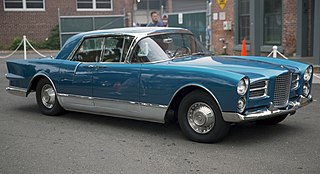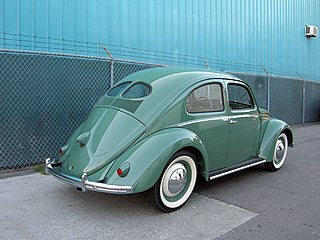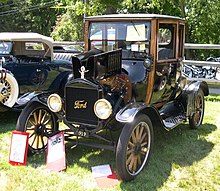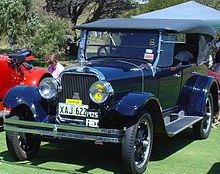
A model car, or toy car, is a miniature representation of an automobile. Other miniature motor vehicles, such as trucks, buses, or even ATVs, etc. are often included in this general category. Because many miniature vehicles were originally aimed at children as playthings, there is no precise difference between a model car and a toy car, yet the word 'model' implies either assembly required or the accurate rendering of an actual vehicle at smaller scale. The kit building hobby became popular through the 1950s, while the collecting of miniatures by adults started to pick up momentum around 1970. Precision-detailed miniatures made specifically for adults are a significant part of the market since the mid-1980s.

American Motors Corporation was an American automobile manufacturing company formed by the merger of Nash-Kelvinator Corporation and Hudson Motor Car Company on May 1, 1954. At the time, it was the largest corporate merger in U.S. history.

Packard was an American luxury automobile company located in Detroit, Michigan. The first Packard automobiles were produced in 1899, and the last Packards were built in South Bend, Indiana in 1958.
The Classic Car Club of America (CCCA) is an organization founded in 1952 to celebrate the grand automobiles of the prewar period. At the time, the vehicles covered by the club were considered too modern to be of any interest by such organizations as the Antique Automobile Club of America, and despite their often stupendous cost when new, were considered practically worthless.

Personal luxury car is a North American car classification describing somewhat sporty, sophisticated mass-market coupés that emphasized comfort over performance. The North American manufacturers most often combined engineering, design, and marketing to develop upscale, distinctive "platform sharing" models that became highly profitable.
There is no fixed definition of a classic car. They are usually older cars, typically 25 years or older, though definitions vary. A common theme is of an older car of historical interest to be collectible and tend to be restored rather than scrapped, though sometimes age is not a factor. Classic cars are often considered a subset of a broader category of "collector cars". A subset of what is considered classic cars are known as antique cars or vintage cars.

An antique car is an automobile that is an antique. Narrower definitions vary based on how old a car must be to qualify. The Antique Automobile Club of America defines an antique car as over 25 years of age. However, the legal definitions for the purpose of antique vehicle registration vary widely. The antique car era includes the Veteran era, the Brass era, and the Vintage era, which range from the beginning of the automobile up to the 1930s. Later cars are often described as classic cars. In original or originally restored condition antiques are very valuable and are usually either protected and stored or exhibited in car shows but are very rarely driven.

A car platform is a shared set of common design, engineering, and production efforts, as well as major components, over a number of outwardly distinct models and even types of cars, often from different, but somewhat related, marques. It is practiced in the automotive industry to reduce the costs associated with the development of products by basing those products on a smaller number of platforms. This further allows companies to create distinct models from a design perspective on similar underpinnings. A car platform is not to be confused with a platform chassis, although such a chassis can be part of an automobile's design platform, as noted below.

The Jeep Wagoneer is a luxury 4×4 produced and marketed under the Jeep brand, which was owned by successive automakers from 1962 to 1991. Described when it was introduced as a station wagon body style, the innovative concept by industrial designer Brooks Stevens over time pioneered the luxury "sport utility vehicle" (SUV).

Development of the automobile started in 1672 with the invention of the first steam-powered vehicle, which led to the creation of the first steam-powered automobile capable of human transportation, built by Nicolas-Joseph Cugnot in 1769. Inventors began to branch out at the start of the 19th century, creating the de Rivaz engine, one of the first internal combustion engines, and an early electric motor. Samuel Brown later tested the first industrially applied internal combustion engine in 1826.

The Facel VegaExcellence is a luxury saloon automobile produced by French manufacturer Facel Vega, that was unveiled at the Paris Auto Show in October 1956.

The Hudson Greater Eight is a luxury car that was produced by the Hudson Motor Car Company of Detroit, Michigan during 1931 and 1932.

The Rambler Marlin is a two-door fastback automobile produced in the United States by American Motors Corporation from 1965 to 1967. A halo car for the company, it was marketed as a personal luxury car.
Hemmings Motor News (HMN) is a monthly magazine catering to traders and collectors of antique, classic, and exotic sports cars. It is the largest and oldest publication of its type in the United States, with sales of 215,000 copies per month, and is best known for its large classified advertising sections. The magazine counts as subscribers and advertisers practically every notable seller and collector of classic cars, including Jay Leno and his Big Dog Garage, and most collector car clubs are included in its directory.

Conservation and restoration of road vehicles is the process of restoring a vehicle back to its original working condition, whether the car is partially scrapped or completely totaled. Automotive restoration can be applied to many different eras of the automobile. Bus preservation groups aim to purchase buses of various eras to restore them to their original operating condition. Buses are often restored to the original authentic livery of their original owner.

In the United States, the automotive industry began in the 1890s and, as a result of the size of the domestic market and the use of mass production, rapidly evolved into the largest in the world. The United States was the first country in the world to have a mass market for vehicle production and sales and is a pioneer of the automotive industry and mass market production process. During the 20th century, global competitors emerged, especially in the second half of the century primarily across European and Asian markets, such as Germany, France, Italy, Japan and South Korea. The U.S. is currently second among the largest manufacturers in the world by volume.

The 1950s were pivotal for the American automobile industry. The post-World War II era brought a wide range of new technologies to the automobile consumer, and a host of problems for the independent automobile manufacturers. The industry was maturing in an era of rapid technological change; mass production and the benefits from economies of scale led to innovative designs and greater profits, but stiff competition between the automakers. By the end of the decade, the industry had reshaped itself into the Big Three, Studebaker, and AMC. The age of small independent automakers was nearly over, as most of them either consolidated or went out of business.

The Chrysler Pacifica is a minivan produced by the Chrysler division of Stellantis. It is unrelated to the discontinued crossover and concept vehicles by the same name and replaced the Chrysler Town & Country for the 2017 model year. It is positioned as the higher-end Chrysler minivan, above the Dodge Grand Caravan until 2020 and above the Chrysler Voyager since 2020.

The Martin Auto Museum is a privately owned non-profit automobile museum located in Glendale, Arizona. The museum is dedicated to the preservation of collectible automobiles for educational purposes. Admission is a $10 donation per person over the age of 12. Some of the services provided by the museum include guided tours for such groups as local schoolchildren, veteran organizations and car clubs.
The Academy of Art University Automobile Museum is a non-profit museum located in San Francisco, California. The museum serves both as a conservator of automotive history and as a tool for students in the industrial design department at the Academy of Art University, particularly those in the Automotive Restoration program.





















